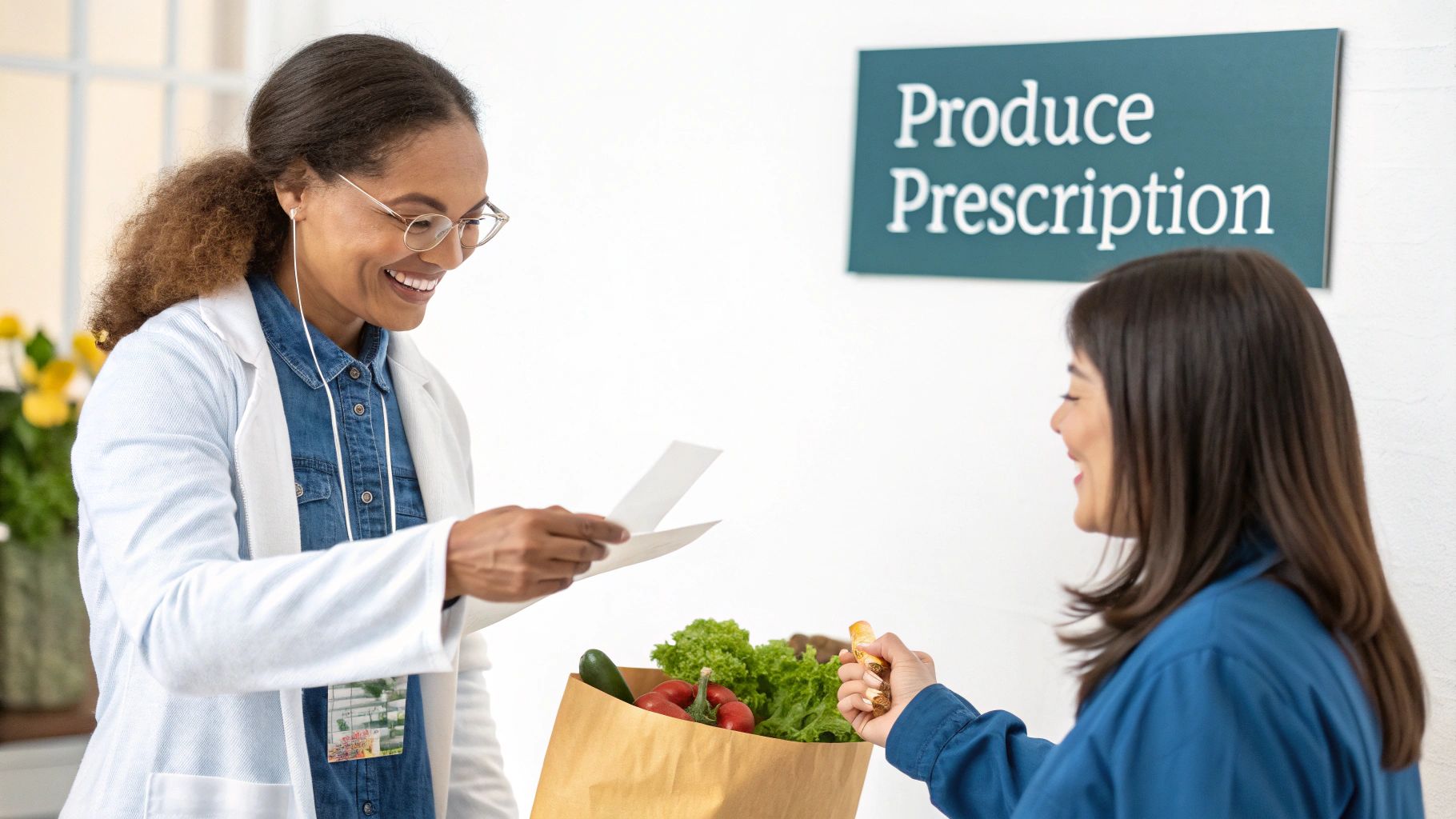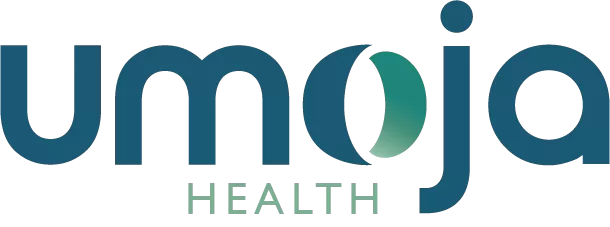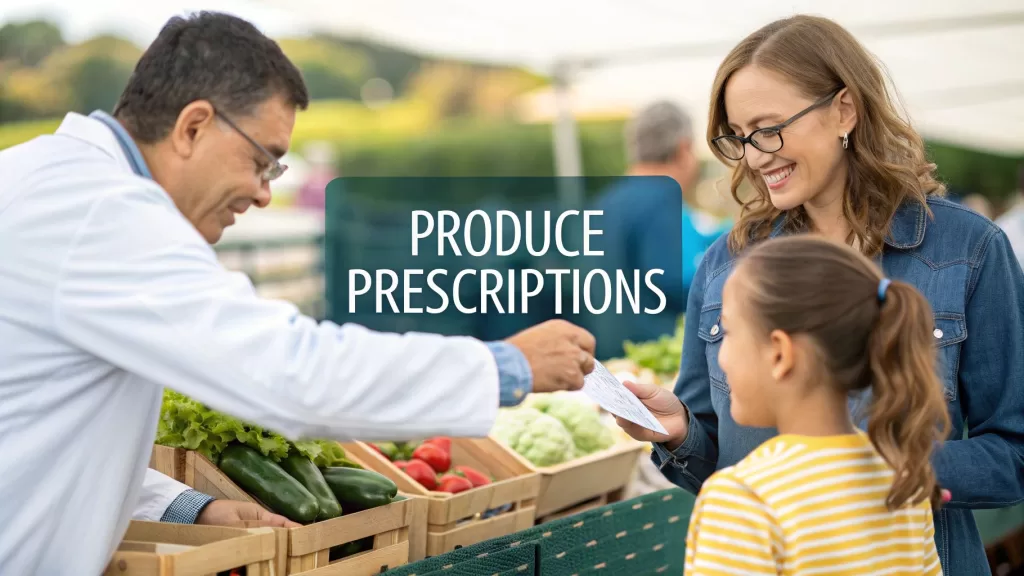Produce prescription programs are a powerful healthcare intervention where providers prescribe fresh fruits and vegetables to patients with diet-related chronic illnesses. This "food as medicine" approach is about more than just good advice; it gives patients the financial means or direct access to healthy produce, aiming to improve health outcomes and tackle nutrition insecurity head-on.
What Are Produce Prescription Programs?

At its core, a produce prescription program connects healthcare and food access. The concept is simple but profound: a clinician identifies a patient with a specific health need—like diabetes, hypertension, or obesity—and writes a "prescription" for fresh produce. This isn't just a suggestion to eat better; it's a tangible tool that empowers patients to make healthier choices they might not otherwise be able to afford.
These programs are a cornerstone of the broader food is medicine movement, which recognizes that nutrition plays a critical role in managing and preventing chronic disease. By directly addressing food insecurity, these programs work to dismantle the financial barriers that keep many individuals and families from accessing nutritious food.
Common Program Models
The way produce prescription programs operate can vary significantly, adapting to local needs and resources. The most common models include:
- Voucher Systems: Patients receive coupons or vouchers they can use at participating grocery stores or farmers' markets to "pay" for fruits and vegetables.
- CSA-Style Boxes: Programs partner with local farms or food hubs to provide participants with pre-packed boxes of fresh, seasonal produce, often delivered or available for pickup at the clinic.
- On-Site Distribution: To maximize convenience, some clinics set up their own food pantries or markets where patients can fill their prescriptions right after an appointment.
How Are These Programs Funded?
A successful produce prescription program is built on consistent funding and strong community partnerships. Securing capital while simultaneously weaving a web of support with clinics, food suppliers, and local organizations is essential for getting your program off the ground and sustaining it.
The funding landscape is varied, offering opportunities for programs of all sizes. Federal grants, like the USDA's Gus Schumacher Nutrition Incentive Program (GusNIP), are a major source of support, but competition is fierce.
Other key funding avenues include:
- State and Local Government: Many state departments of health or agriculture have grants focused on nutrition security and local food systems.
- Private Foundations: Focus on foundations whose missions center on community health, food access, or chronic disease prevention.
- Healthcare Payers: Managed care organizations and health systems are increasingly willing to fund pilot programs, especially those that can show a potential return on investment through better health outcomes.
From our own grant-writing experience at Umoja Health, we've learned that a compelling story backed by solid data is absolutely critical. We've always focused on demonstrating a clear, scalable workflow and a robust plan for measuring outcomes. Funders don't just want a good idea; they want to see a sustainable model that can prove its impact. One of our biggest wins came from a grant that required a collaboration between a healthcare provider and a community-based food organization. We built that partnership before starting the application and co-wrote the proposal, which showed we had a unified, ready-to-execute plan that made us stand out.
Key Operational Considerations
Once funding is secured, you must build the practical, day-to-day workflow that brings your produce prescription program to life. A solid operational plan is the backbone of a successful program, ensuring a smooth experience for every participant.
Think of this phase as translating your vision into clear, scalable processes.
Building a Scalable Workflow for New Clinics & Nonprofits
Designing an effective program requires a methodical approach. The infographic below outlines the foundational steps—from securing funding to building a resilient partner network that can deliver produce reliably.
Here is a scalable workflow that new clinics or nonprofits can adapt:
- Define Patient Eligibility: Establish clear criteria based on medical diagnoses (e.g., type 2 diabetes, hypertension), a positive food insecurity screening, and any geographic requirements tied to funding. A sharply defined target population and a low-barrier enrollment process are critical.
- Forge Key Partnerships: Identify and formalize relationships with clinical partners (for referrals), food suppliers (local farms, food hubs, grocery stores), and community organizations (for outreach and support). Create clear Memorandums of Understanding (MOUs) outlining roles, responsibilities, and data-sharing protocols.
- Choose a Distribution Model: Select a model—voucher, direct delivery, or on-site pantry—that best fits your community’s needs, partner capabilities, and budget. Applying sound project management best practices during planning is key.
- Manage Logistics and Compliance: Develop systems for inventory management, ensure the cold chain is maintained for food safety, and offer culturally relevant food options to drive engagement. If using federal funds, understand requirements like Buy American provisions. For organizations building these systems, understanding produce kitting and cold chain logistics is critical.
- Establish Data Collection Protocols: From day one, implement a plan to track process, behavioral, and clinical metrics. This data is essential for reporting to funders and making the case for long-term sustainability.
Comparison of Produce Prescription Delivery Models
This table breaks down the three primary operational models to help you find the right fit.
| Model Type | Key Advantages | Logistical Challenges | Best Suited For |
|---|---|---|---|
| Voucher System | High participant choice and autonomy. Leverages existing retail infrastructure. | Requires retailer agreements and technology for tracking. Potential for fraud. | Communities with accessible grocery stores or farmers' markets. |
| Direct Delivery (CSA-Style) | High convenience for participants with mobility or transport issues. Strong connection to local farms. | Complex logistics (packing, routing, delivery). Less participant choice in produce selection. | Programs targeting homebound seniors, individuals with disabilities, or those in rural areas. |
| On-Site Pantry/Market | Extremely convenient for patients (co-located at clinic). Reduces stigma. | Requires physical space, refrigeration, and consistent inventory management. | Clinics or hospitals with available space and a high volume of eligible patients. |
Choosing a model isn't just a logistical decision—it shapes the entire participant experience.
Measuring Program Impact and Reporting Outcomes

Good data tells a powerful story. For any produce prescription program, collecting the right information is about proving your value, making a rock-solid case for more funding, and making smart improvements that better serve your community. The goal is to translate your successes into hard evidence that funders and healthcare partners can't ignore.
Key Metrics for a Complete Picture
A balanced mix of process, behavioral, and clinical outcomes provides a 360-degree view of your program’s performance.
- Process Metrics: These tell you how well your program is running. Key indicators include redemption rates (what percentage of benefits are used?) and participant retention (how many people stick with the program?).
- Behavioral Metrics: These measure changes in habits. A validated dietary screener can track shifts in fruit and vegetable consumption. Qualitative data from participant surveys can capture powerful insights into improved food security and reduced stress.
- Clinical Metrics: This is often the holy grail for healthcare partners. Track changes in HbA1c levels (for diabetes), blood pressure (for hypertension), and Body Mass Index (BMI). Note: A HIPAA-compliant data-sharing agreement with your clinical partner is non-negotiable for accessing this data.
Umoja’s Outcomes Data
Our experience at Umoja has taught us that focusing on a few key indicators provides the clearest evidence of health impact. Our data mirrors what many produce prescription programs are seeing nationwide: significant improvements in food security and modest but meaningful reductions in weight.
For example, in one recent 12-week program, we observed that:
- 68% of participants reported an improvement in their food security.
- The group saw an average weight loss of 4.2 pounds.
It’s crucial to be transparent about complexities. While improvements in diet and weight are common, changes in biomarkers like HbA1c can be harder to isolate due to factors like concurrent medication use. A study of a Chicago-based program found sustained weight loss but no statistically significant drop in HbA1c, highlighting how nuanced the impact can be. You can better understand the complexities of clinical outcomes in the full study.
Presenting a balanced view of your outcomes builds credibility and contributes to a more honest national conversation about the true power of food as medicine.
Making the Case for System-Wide Adoption
To truly scale produce prescription programs, we must move them from grant-funded projects to an essential, standard component of healthcare. The endgame is to embed these programs so deeply into our healthcare infrastructure that a prescription for fresh broccoli becomes as routine as one for metformin.
This isn’t a niche idea. Public support is strong, with nearly 80% of Americans believing insurance should cover nutrition access to help manage chronic diseases that drive $1.1 trillion in annual healthcare costs. Yet, there's an awareness gap; only 13% of Americans know these programs exist. You can dig into the public's demand for food as medicine coverage to learn more.
Framing a Cost-Effective Investment
Broader adoption requires framing these programs as a smart, cost-effective investment in community health. The conversation with payers and policymakers must focus on cost avoidance and long-term savings through:
- Fewer ER visits for complications from diabetes or hypertension.
- Reduced hospital readmissions for diet-sensitive conditions.
- Lower long-term spending on pharmaceuticals.
This shifts the narrative from a social program to a strategic financial move. To get this message across effectively, it's worth exploring modern communication tools like interactive video marketing strategies for adoption to make your case.
Advocating for Policy Change and Reimbursement
Insurance reimbursement is the key to unlocking sustainability and true scale. This requires a coordinated advocacy effort aimed at changing policies. Working with Managed Care Organizations (MCOs) to include produce prescriptions as a covered supplemental benefit is a viable pathway.
The challenge lies in building a robust evidence base that is impossible to ignore. Every program, regardless of size, must prioritize meticulous data collection. This collective data becomes the fuel for policy change.
Evidence Table Supporting Produce Prescription Program Impact
The data is what convinces skeptics and drives policy. This table summarizes key findings from various studies, providing a snapshot of the evidence that proves the impact of produce prescription programs across several critical areas.
| Outcome Metric | Summary of Evidence | Key Findings & Statistics | Source Type |
|---|---|---|---|
| Food Security | Consistently strong evidence shows significant improvement in household food security and reduced stress related to food access. | Programs frequently report a 50-70% reduction in food insecurity among participants after 6-12 months. | Peer-Reviewed Studies & Program Reports |
| Dietary Intake | Strong evidence indicates a notable increase in fruit and vegetable consumption among participants. | Participants often increase daily fruit and vegetable intake by 0.8 to 1.5 servings per day. | Validated Dietary Screeners (e.g., NCI screener) |
| Glycemic Control (HbA1c) | Evidence is mixed but promising. Reductions are often observed but may not always reach statistical significance, sometimes due to medication changes. | Some studies show modest HbA1c reductions of 0.2 to 0.6 percentage points, particularly in high-engagement groups. | Clinical Trials & Observational Studies |
| Weight Management | Moderate to strong evidence supports modest but sustained weight loss or prevention of weight gain. | Participants often experience an average weight loss of 3-5 pounds over a 6-month program. | Program Evaluations & Cohort Studies |
| Healthcare Costs | Emerging evidence suggests potential for cost savings, though more long-term research is needed to quantify the full impact. | Pilot models estimate potential healthcare cost savings ranging from $500 to $2,000 per participant annually. | Economic Modeling & Pilot Payer Studies |
Each piece of data contributes to a larger story. By collecting, analyzing, and sharing these outcomes, we build an undeniable argument that investing in food is one of the smartest investments we can make in health.
Common Questions We Get About Produce Prescription Programs
When planning or running a produce prescription program, practical questions inevitably arise. Here are some of the most common inquiries we receive, along with our real-world answers.
What’s the Real Cost Per Participant?
The budget for a produce prescription program typically ranges from $30 to $100 per participant per month. This figure depends on your program model, location, and intervention length.
Remember, this budget isn't just for the produce. You must also factor in operational costs:
- Administrative Lift: Staff time for logistics, enrollment, and participant support.
- Tech Stack: Software to track vouchers, manage deliveries, and collect data.
- Direct Program Costs: Sourcing and transporting produce, printing materials, and data collection tools.
Pro Tip: When writing grants, build in all direct and indirect costs. Securing multi-year funding is the gold standard, giving you the runway to measure the long-term health impacts that make a powerful case for future investment.
How Do You Navigate Patient Privacy and HIPAA?
When partnering with a healthcare provider, HIPAA compliance is non-negotiable. Any patient information you handle is Protected Health Information (PHI) and must be protected.
First, you must have a Business Associate Agreement (BAA) signed with any clinical partners. All data must be stored on secure, encrypted platforms with access limited to authorized staff. When reporting results, all data must be de-identified and shared in aggregate to protect individual privacy. Ensure all staff and volunteers receive thorough training on HIPAA rules.
What Are the Biggest Hurdles to Participant Retention?
Participant retention can be challenging. The biggest hurdles are often practical life issues, such as transportation barriers, inconvenient distribution times, or receiving unfamiliar vegetables.
The key to boosting retention is to make the program relentlessly user-friendly:
- Be Flexible: Offer multiple pickup windows or explore home delivery options.
- Educate and Empower: Share simple recipes, host cooking demos, and offer food storage tips.
- Build Relationships: Check in with participants regularly and ask for feedback. When people feel supported, they are more likely to stick with it.
Can Participants Use Their SNAP or WIC Benefits, Too?
Yes, absolutely! Produce prescription benefits are designed to supplement, not replace, federal nutrition programs like SNAP and WIC. Encourage participants to use them together to stretch their total food budget. For instance, a participant could use a produce prescription voucher at a farmers' market and their SNAP EBT card for other groceries. Clear communication is key to ensuring participants understand how these benefits work together.
At Umoja Health, we design and supply compliant, culturally connected food programs that move the needle on health outcomes. From Food is Medicine grocery boxes to large-scale disaster response, we provide the logistical backbone and food sourcing expertise to help you serve your community effectively. Learn how we can support your mission.

